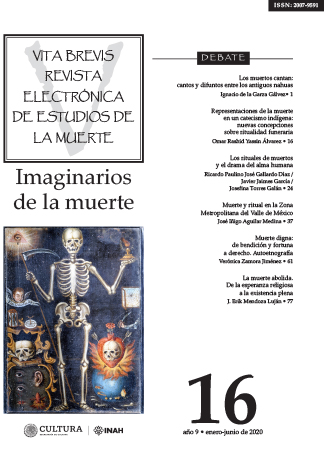La muerte abolida. De la esperanza religiosa a la existencia plena
Keywords:
Death, Eschatology, Systems of hope, ReligionAbstract
Life is opposed to death, opposite poles in the same continuum, two irreconcilable truths, as opposed to the idea of birth as genesis and death as apocalypse. Idealizing on continuums as straight or cyclical lines leads us to imagery of an existence in infinite time. That is, creating systems of hope that will help us free ourselves from the anguish caused by the consciousness of finitude, creating self-defense by psychologically removing ourselves from the situation that causes anguish. More than an anguish to the unknown of death is not being able to control their life time. Man’s time has a beginning and an end, this is what linear time refers to, in which one pole is opposed to the other, without ever touching its tips, while time has a cyclical form, in which the beginning is the end and vice versa. The idea of linear time in man causes terror, fear of the end, therefore it tries to abolish the linearity of time to make it cyclical. The way in which this line is suppressed is through the symbols contained in the myths and rites of each society-culture, turning into a cycle that which has a beginning and an end.
Downloads
References
Abbagnano, Nicola, Diccionario de Filosofía, México, FCE, 1961.
Ariés, Philippe, El hombre ante la muerte, Madrid, Taurus Humanidades, 1982.
Blanck-Cerejeido, Fanny, La vida, el tiempo y la muerte, México, FCE, 1982.
Carse, James P., Muerte y existencia. México, FCE, 1987.
Derrida, Jacques, Dar la muerte. España Paidós, 2006.
Elias, Norbert, La soledad de los moribundos, México, FCE, 1989.
Freud, Sigmund, “Inibizione, sintomo, angoscia”, en Opere, trad. It., vol. X, Turín, 1978, p. 278.
Gluckman, M., Essays in the ritual of Social Relation, Manchester, 1962.
Jankélévitch, Vladimir, La muerte, Valencia, Pre-Textos, 2002.
Klarsteld, André y Frederic Revah, Biologie de la mort, Madrid, Editorial Complutense, 2002.
Mendoza Luján, J. Erik, Día de muertos en la Mazateca. Una mirada desde la antropología del comportamiento, México, INAH, 2005. —, “Hay muertos que no hacen ruido… La Antropología de la Muerte, una línea de trabajo”, Diario de Campo, México, núm. 64, 2004, pp. 20-22.
Olivé, León, “La muerte. Algunos problemas filosóficos”, Ciencias, núm. 38, abril-junio de 1995, pp. 55-65.
Parkes, C.M., Bereavment. Studies of Grief in Adult Life, Londres, Hardmondsworth, 1972.
Ruffié, Jacques, El sexo y la muerte, Madrid, Espasa-Calpe, 1988.
Sartre, J. P., L’être et le néant, Paris, Editions du Seuil, 1980, p. 95.
Thomas, Louis-Vincent, Antropología de la muerte, México, FCE, 1989. —, El cadáver, de la biología a la antropología, México, FCE, 1980. —, La muerte, Barcelona, Paidós Studio, 1991.
Downloads
Published
How to Cite
Issue
Section
License
Copyright (c) 2020 Instituto Nacional de Antropología e Historia

This work is licensed under a Creative Commons Attribution-NonCommercial 4.0 International License.



